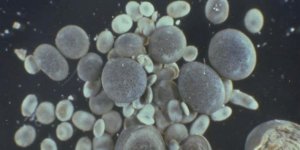| News / Science News |
Scientists Uncover Origins of the Sun’s Swirling Spicules
At any given moment, as many as 10 million wild jets of solar material burst from the sun’s surface. They erupt as fast as 60 miles per second, and can reach lengths of 6,000 miles before collapsing. These are spicules, and despite their grass-like abundance, scientists didn’t understand how they form. Now, for the first time, a computer simulation — so detailed it took a full year to run — shows how spicules form, helping scientists understand how spicules can break free of the sun’s surface and surge upward so quickly.

Scientists used a combination of computer simulations and observations to determine how spicules form. ![]()
This work relied upon high-cadence observations from NASA’s Interface Region Imaging Spectrograph, or IRIS, and the Swedish 1-meter Solar Telescope in La Palma, in the Canary Islands. Together, the spacecraft and telescope peer into the lower layers of the sun’s atmosphere, known as the interface region, where spicules form.
Spicules are transient, forming and collapsing over the course of just five to 10 minutes.
A team of scientists has been working on this particular model for nearly a decade, trying again and again to create a version that would create spicules. But the scientists knew something was missing because they never saw spicules in the simulations.
The key, the scientists realized, was neutral particles. They were inspired by Earth’s own ionosphere, a region of the upper atmosphere where interactions between neutral and charged particles are responsible for many dynamic processes.
The research team knew that in cooler regions of the sun, such as the interface region, not all gas particles are electrically charged. Some particles are neutral, and neutral particles aren’t subject to magnetic fields like charged particles are.
The model began with a basic understanding of how plasma moves in the sun’s atmosphere. Constant convection, or boiling, of material throughout the sun generates islands of tangled magnetic fields.
When boiling carries them up to the surface and farther into the sun’s lower atmosphere, magnetic field lines rapidly snap back into place to resolve the tension, expelling plasma and energy. Out of this violence, a spicule is born.
Neutral particles provide the buoyancy the gnarled knots of magnetic energy need to rise through the sun’s boiling plasma and reach the chromosphere. There, they snap into spicules, releasing both plasma and energy. Friction between ions and neutral particles heats the plasma even more, both in and around the spicules.
The scientists’ updated model revealed something else about how energy moves in the solar atmosphere. It turns out this whip-like process also naturally generates Alfvén waves, a strong kind of magnetic wave scientists suspect is key to heating the sun’s atmosphere and propelling the solar wind, which constantly bathes our solar system and planet with charged particles from the sun.
The simulations indicate spicules could play a big role in energizing the sun’s atmosphere, by constantly forcing plasma out and generating so many Alfvén waves across the sun’s entire surface. (NASA)
YOU MAY ALSO LIKE





